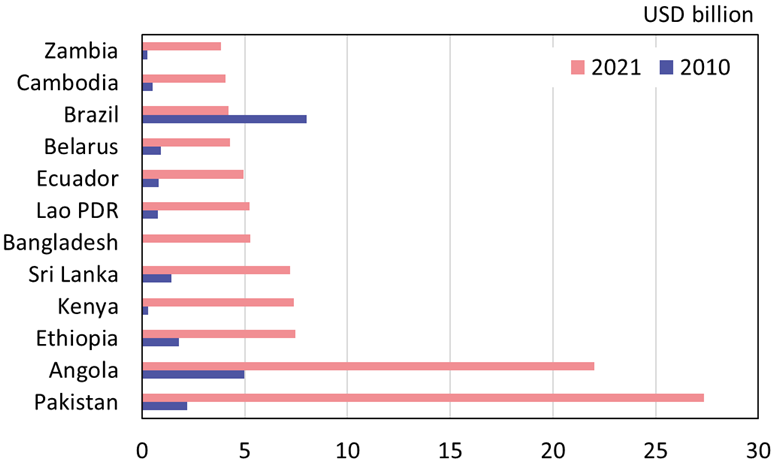BOFIT Weekly Review 18/2023
China sees overseas lending risks materialise during Covid-19 pandemic
Over the past decade, China emerged as the world’s largest bilateral lender to developing and emerging economies. World Bank figures show that Chinese lending to low-and middle-income countries stood at 180 billion dollars at the end of 2021, which was four times more than ten years ago. Most Chinese lending has gone to Asian countries, with Pakistan the largest borrower (27 billion dollars). The top African recipient of Chinese loans is Angola (20 billion dollars). The World Bank’s debt figures, however, have been criticised for their incompleteness. China’s actual international lending to developing and emerging countries is by some estimates more than double that show in the World Bank’s International Debt Statistics. This is because some loan arrangements are classified information and the recipient can, for example, be a state-owned company excluded from the debt statistics. Moreover, the Chinese government typically does not engage directly in lending, but rather lends via its main two policy banks, China Development Bank (CDB) and Export-Import Bank (ExIm Bank), or to a lesser extent through its massive state-owned banks. In China’s view, each of the abovementioned banks is an independent lender, even if it is quite clear that policy banks in particular are strongly subject to government control and guidance.
Many developing and emerging economies borrowed from international lenders in the past decade. The Covid-19 Pandemic, in particular, caused major damage to these economies and exacerbated their debt problems. In early 2020, the IMF, the World Bank and G20 countries reached a temporary agreement on suspension of loan payments from over 70 low-income countries (Debt Service Suspension Initiative). It was clear already then that many countries would eventually face debt restructuring. Debt restructuring talks, which are often quite difficult, have been traditionally handled under the auspices of the Paris Club of creditor countries. Despite being a major creditor, China is not a member of the Paris Club and has not sought membership.
To get China to join other creditors at the debt negotiating table, G20 countries, supported by the IMF and World Bank, agreed on setting up Common Framework for Debt Treatments (CFDT) in autumn 2020 to deal with low-income debtor countries in trouble. Countries that have asked help under the framework so far are Chad (China loans of 0.3 billion dollars at 2021), Zambia (3.8 billion dollars), Ghana (1.7 billion dollars) and Ethiopia (7.4 billion dollars). Of these countries only Chad has been able to restructure its debt in bilateral talks with creditors outside the CFDT. Talks with other countries under the CFDT have been in limbo as creditors have been unable to agree on restructuring principles.
Finding common ground has been difficult in particular due to Chinese so far have been unable to agree on suitable debt restructuring models that require the creditor to take a “haircut” on troubled loans, especially given that the IMF, World Bank and other international institutional lenders are traditionally excluded from the haircut requirement. Instead, Chinese lenders prefer to extend loan times. Last autumn, for example, Ecuador, which has borrowed about 5 billion dollars from China, entered into bilateral talks based on a common understanding on extending the maturity dates on loans from two of its biggest Chinese lenders (CDB and ExIm Bank). Another seriously distressed borrower, Sri Lanka (7.2 billion dollar in loans from China), was offered a two-year suspension of its debt-servicing payments to ExIm Bank. In February, China offered Pakistan, a country struggling with severe financial problems, an additional loan of 700 million dollars on top of its existing 27.4 billion dollars in debt to Chinese lenders.
Chinese loans to developing and emerging economies are tempting to many borrowers. They typically are granted without social advancement requirements such as for example reducing the child-labour force. For this reason, poor countries are often willing to pay higher interest rates than loans with social conditions attached. China also offers financing for turn-key projects that include Chinese engineering and project implementation. In some cases, the loan can eventually be paid off in raw materials generated by the project. Suspicions have been voiced that Chinese lenders might also offer persons in positions of power personal benefits when lobbying for Chinese loans. Despite common fears about China’s predatory lending practices, however, there seems to be is little evidence to back up such claims. Instead, China’s biggest problems as a lender have to do with incompetent evaluation of proposed projects and risk assessment. In any case, Chinese lending has given it greater influence in developing and emerging economies.
Chinese lending to low- and middle-income countries increased sharply over the past decade
Sources: World Bank International Debt Statistics (IDS) and BOFIT.